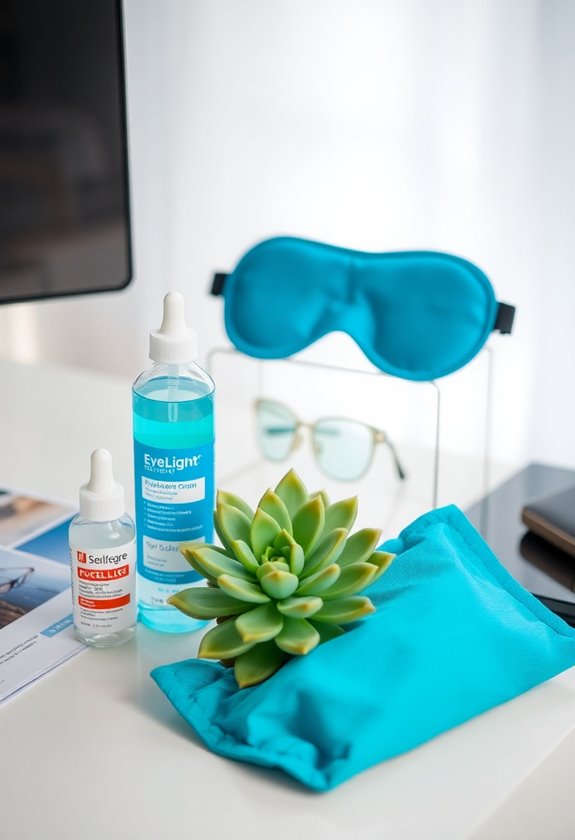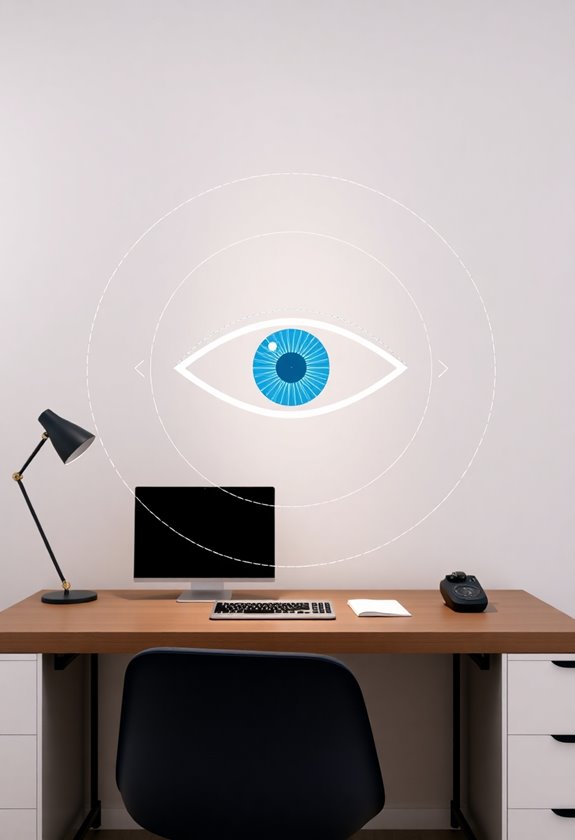A 7-day screen time detox can help you overcome digital anxiety and restore balance to your tech habits. You'll start by setting clear daily limits for device usage while establishing screen-free zones in your home. Throughout the week, incorporate mindfulness practices and scheduled breaks to manage stress responses and improve concentration. Replace excessive screen time with outdoor activities and face-to-face social connections, using productivity apps to track your progress. Focus on building sustainable habits through gradual reductions and regular self-assessment. This structured approach will guide you toward lasting digital wellness and reduced anxiety as you explore each phase of the detox journey.
Highlights
- Begin with a 24-hour digital detox on Day 1, followed by gradual reintroduction of essential screen activities only.
- Replace screen time with mindfulness exercises, outdoor activities, and face-to-face social interactions throughout the week.
- Create designated screen-free zones in your home and implement strict usage boundaries during meals and before bedtime.
- Use screen time tracking apps to monitor progress and set daily limits that decrease progressively over seven days.
- Practice stress-relief techniques like deep breathing and meditation when experiencing digital anxiety or withdrawal symptoms.
Understanding Digital Anxiety
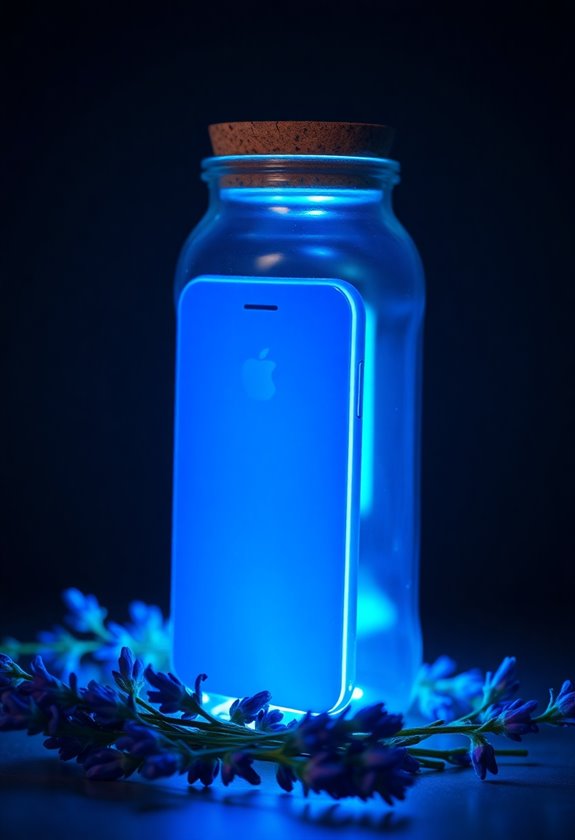
In today's hyperconnected world, digital anxiety has become an increasingly common mental health concern. You're likely experiencing this modern affliction if you feel stressed about constant connectivity, struggle with information overload, or worry about missing important updates on your social media feeds. Young individuals tend to experience higher anxiety levels when engaging with digital platforms. Exploring natural anxiety remedies can help restore balance while navigating digital spaces.
Digital anxiety manifests through both psychological and physical symptoms that can greatly impact your daily life. You'll notice increased heart rate and restlessness when separated from your devices, while the psychological burden of maintaining a perfect online presence may leave you feeling inadequate or overwhelmed. The constant pressure to stay connected, combined with endless social comparisons and cyberbullying concerns, can trigger serious stress responses that affect your sleep patterns, concentration, and overall well-being.
Reset Your Screen Time Goals
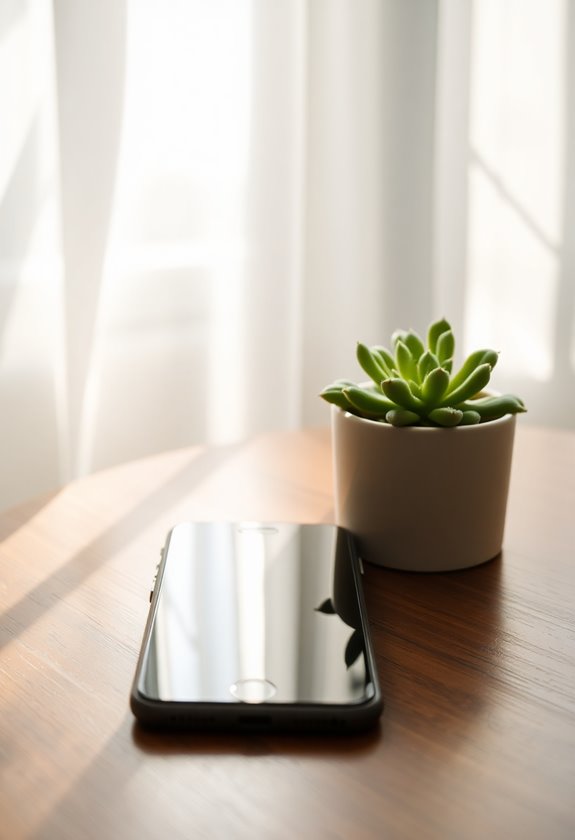
Taking control of your screen time starts with setting clear, actionable goals that align with your lifestyle and digital wellness needs. You'll want to establish specific daily limits for different activities, from social media browsing to video streaming, while using built-in features or third-party apps to track your progress. Consider playing concentration music in the background to maintain better focus during your permitted screen activities.
Start by creating a balanced schedule that includes designated screen-free periods throughout your day, and don't forget to prioritize face-to-face interactions whenever possible. Setting up device-free zones in your home can create dedicated spaces for uninterrupted focus and relaxation. You can make the shift easier by implementing gradual reductions – begin with small, manageable decreases in screen time rather than dramatic changes. Consider using productivity apps that block distracting websites and set regular reminders for screen breaks, which will help you maintain focus while working toward your digital wellness goals.
Create Screen Free Zones

Once you've set your screen time goals, creating dedicated screen-free zones can help solidify your new digital habits. Start by designating specific areas in your home where screens aren't welcome, such as your bedroom, dining room, and a cozy reading nook for relaxation. Having stress relief tools like squeeze balls in these zones can provide an engaging alternative when digital cravings hit.
At work, you'll want to establish clear boundaries by implementing screen-free periods during meetings and creating quiet spaces for device-free breaks. These zones will help reduce anxiety while promoting better sleep patterns and stronger relationships with colleagues and family members. Sustained attention spans naturally improve as you eliminate digital distractions from your workspace.
To maintain these boundaries effectively, set clear guidelines and use physical reminders like signs or designated storage areas for devices. You'll need to be patient and consistent as you gradually expand these screen-free periods, but the benefits to your mental health and social connections are worth the effort.
Mindful Technology Usage Strategies
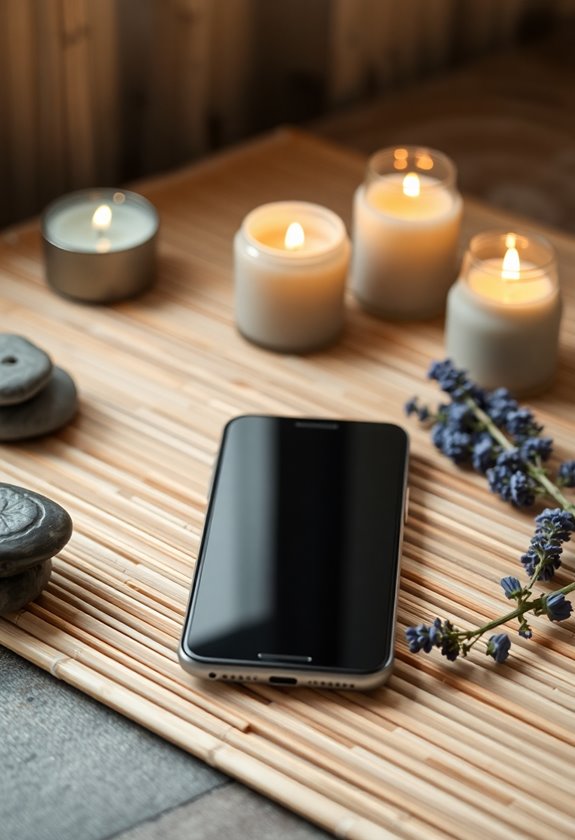
Mindful technology usage begins with three key elements: awareness, intention, and balance. You'll need to consciously evaluate how you're using your devices and whether that usage aligns with your personal goals and values. Research shows that excessive screen time can contribute to increased anxiety and depression symptoms. Consider wearing blue light glasses while working to reduce digital eye strain and promote better sleep quality.
To develop mindful tech habits:
- Schedule specific times for checking emails and social media
- Use mindfulness apps to build focused attention and stress management skills
- Set up tech-free zones in your bedroom and dining areas
- Practice the Pomodoro Technique to incorporate regular breaks
- Turn off non-essential notifications to reduce digital distractions
Remember to regularly assess your technology habits through journaling or self-reflection exercises, making small adjustments as needed to maintain healthy digital boundaries while maximizing productivity and well-being.
Rebuild In-Person Social Connections

While developing mindful technology habits helps create digital balance, rebuilding meaningful in-person connections deserves equal attention. Start by reaching out to close friends or family members for intimate gatherings, gradually expanding your social circle as your comfort level grows. Practicing relaxation techniques beforehand can help ease anxiety about social interactions.
Set achievable social goals and practice active listening during interactions, showing genuine interest in others' experiences while sharing your own thoughts and feelings when appropriate. You'll want to be intentional about reconnecting with people through personalized messages, understanding that everyone has different comfort levels regarding social interactions.
Balance virtual and face-to-face connections by leveraging video calls as stepping stones to in-person meetings, and remember to prioritize quality interactions over quantity. When challenges arise, approach the rebuilding process with self-compassion and patience, seeking support if needed.
Digital Wellness Action Plan
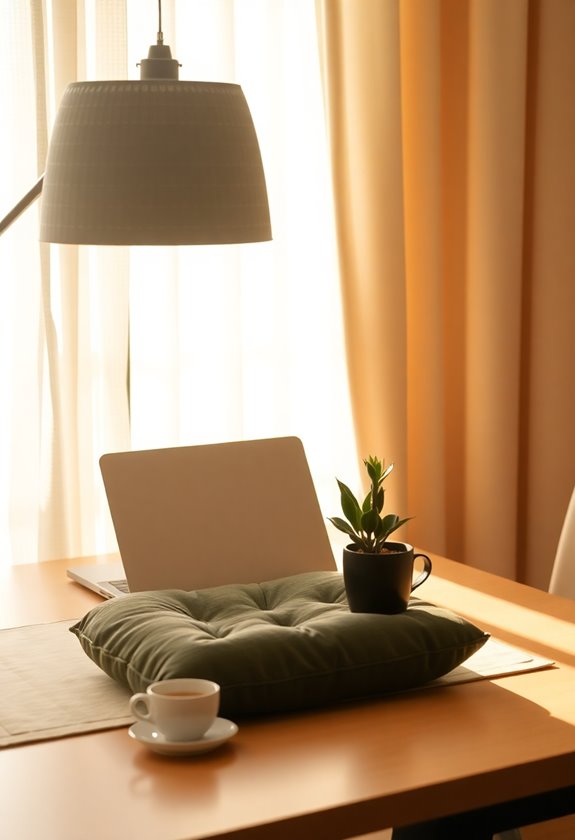
Through careful planning and commitment, creating a digital wellness action plan can transform your relationship with technology. You'll need to establish clear boundaries and implement practical strategies that align with your lifestyle and goals.
- Start by analyzing your current digital habits and identifying triggers that lead to excessive screen time
- Set specific, measurable goals for reducing technology use, such as designating tech-free zones in your home
- Create a structured daily routine that includes regular breaks from screens and alternative activities
Just as anti-fatigue mats provide physical comfort during long standing periods, implementing regular screen breaks helps reduce mental fatigue. Remember to incorporate self-assessment tools to track your progress and adjust your plan as needed. You’re building a sustainable approach to digital wellness that’ll help you maintain a healthy balance between online and offline life while promoting better mental health through mindful technology use. By developing smart work habits, such as setting specific times for screen breaks and incorporating regular physical activity into your routine, you can further enhance your digital wellness. This proactive approach will not only improve your mental well-being but also increase your overall productivity and focus. It’s important to prioritize your well-being in this digital age, and by establishing smart work habits, you’ll be able to achieve a healthier work-life balance.
Sustaining Your Digital Balance
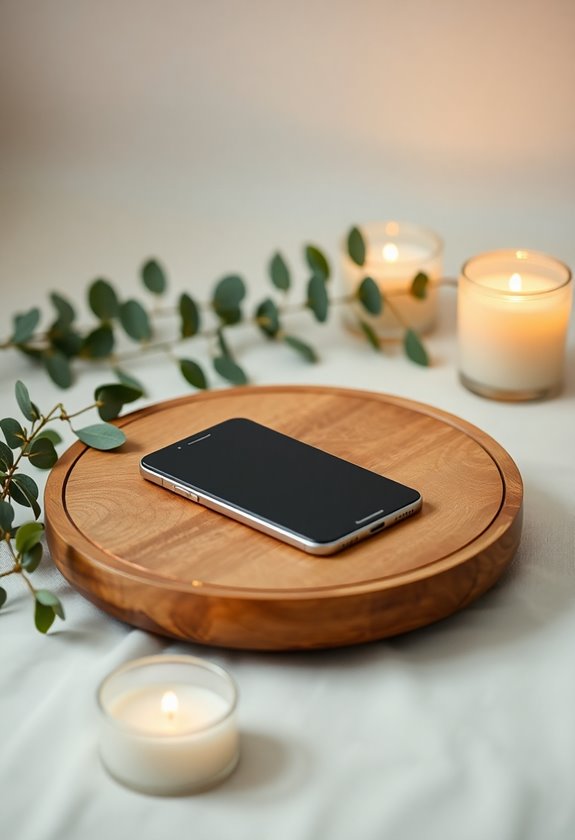
Maintaining digital balance requires ongoing dedication and strategic habits that extend beyond the initial detox period. You'll need to establish specific device usage times and create tech-free zones in your home or workspace to sustain your progress.
To build lasting habits, set clear boundaries by:
- Using digital well-being dashboards to monitor your screen time
- Setting daily limits on non-essential apps
- Implementing "Do Not Disturb" periods during personal time
- Creating designated offline periods for face-to-face interactions
Make mindfulness a priority by regularly disconnecting to engage in offline activities, and you'll find it easier to manage the constant pressure to stay connected. Plan for long-term success by gradually adjusting your digital habits and regularly evaluating your progress toward maintaining a healthier relationship with technology.
Frequently Asked Questions
How Do I Handle Work-Related Screen Time When My Job Requires Constant Computer Use?
Set regular breaks using the 20-20-20 rule: every 20 minutes, look at something 20 feet away for 20 seconds to reduce eye strain. While you can't eliminate computer use, you can optimize it by implementing screen-free meetings, using talk-to-text features, and scheduling focused work blocks. Maximize your productivity during computer time by disabling non-essential notifications and using time-tracking apps to manage your digital workload effectively.
Can Digital Detox Cause Withdrawal Symptoms, and How Long Do They Typically Last?
Like a caffeine craving that nags at your mind, digital detox can trigger real withdrawal symptoms. You'll likely experience anxiety, irritability, and sleep disruptions during the first few days, with symptoms typically lasting between 3-14 days. Your body's reaction might include headaches and restlessness, while your mind may struggle with mood swings and concentration issues, but remember these symptoms will gradually diminish as your system readjusts.
What Should I Do if My Partner Refuses to Participate in Digital Detox?
Start by understanding your partner's concerns and resistance through open communication, then suggest starting with small, manageable steps like tech-free meals together. You can lead by example and make the experience more appealing by planning engaging offline activities you'll both enjoy. If they're still hesitant, consider involving a counselor who can help address underlying concerns and create a balanced approach that works for both of you.
How Can I Maintain Digital Boundaries With Friends Who Expect Instant Responses?
Start by having direct conversations with your friends about your new boundaries, explaining that you're prioritizing your well-being through managed response times. Set specific "communication windows" when you'll check and respond to messages, and stick to them consistently. You can use auto-reply messages to inform others when you'll be available, which helps manage their expectations while maintaining your digital boundaries.
Should I Delete All My Social Media Accounts Permanently After the Detox?
While permanent deletion might seem appealing, you don't need to take such a drastic step to maintain digital wellness. Instead, try implementing sustainable boundaries like setting specific usage times and curating your feed to align with your values. You can start with a temporary deactivation to test how it affects your daily life, then make an informed decision based on your personal experience with the detox.


